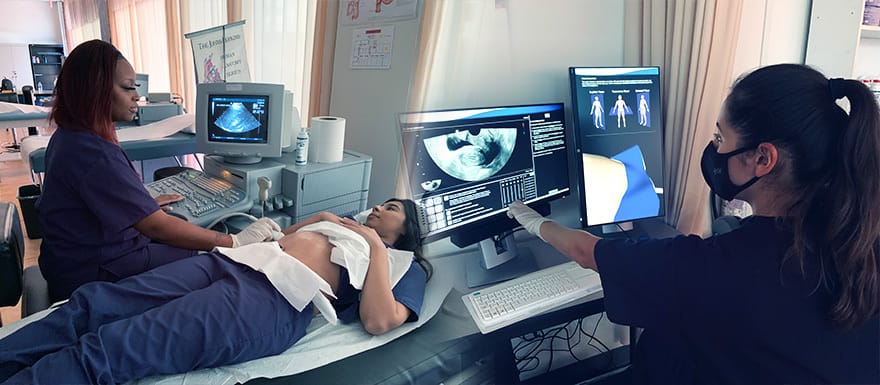
Ever had an ultrasound done while you were pregnant? Do you know how ultrasound machines work? Have you ever considered a career as an Ultrasound Technician? If so, there are a few interesting facts about Ultrasounds and Ultrasound Technicians that may surprise you. Ultrasounds are used for a number of reasons and is a unique diagnostic tool that doctors, Radiologists, and Ultrasound Technicians use to capture real-time images of inside the human body to confirm, diagnose, guide live procedures, or promote healing in Therapeutics.
The ultrasound field is not limited to one particular sector of healthcare. There are many interesting facts about Ultrasounds and Ultrasound Technicians that you may have never known until today. You may be an aspiring Ultrasound Technician or just curious about the world of Ultrasound. If you would like to know 5 interesting facts about ultrasounds and Ultrasound Technicians then continue reading.
There are Different Types of Ultrasounds and Ultrasound Probes
Did you know Ultrasound Technicians use different transducers or probes depending on the type of exam ordered by the doctor? The Ultrasound Machine is one component of an ultrasound examination. Along with the Ultrasound Machine, the Ultrasound Technician utilizes a transducer or probe which is connected to the Ultrasound Machine. By definition, a transducer is a device that converts one form of energy into another. An ultrasound transducer converts electrical energy into high frequency sound waves. Since each transducer is created for a particular part of the body, the Ultrasound Technician will decide which transducer is appropriate for any particular ultrasound examination. There are a few different types of ultrasound transducers that are commonly used which include:
- Linear
- Convex
- Endocavitary
- Phased Array
- 3D/4D
There are many variations of transducers in ultrasounds, but these are some of the most commonly used. The Linear transducers also referred to as a Linear Probe, is generally used for small superficial structures such as; thyroid, breast, arteries or veins. The Convex Probe, is generally used for deeper structures like the abdominal organs which requires a larger field of view and a lower frequency. The Endocavitary Probe is generally used to insert into the vaginal orifice. This type of probe is used to view reproductive organs such as the uterus, fallopian tubes, and ovaries.
Additionally, this type of probe can be used to confirm pregnancy in the early stages. The Phased Array Probe is generally used for cardiac exams which requires the sound waves to reach deeper than the Linear Probe. Finally, the 3D or 4D probe captures slices of images from different sides. The slices of images are then put together to obtain a 3D still image or 4D live image. This type of ultrasound examination is used for recreational purposes and is not generally used for diagnostic purposes. Click the link located below the Additional Resources section at the end of this article for more information about different types of ultrasound probes.
Ultrasounds Are Used in Therapeutics
We know ultrasounds are popular for their role in monitoring pregnancy and fetal growth, but did you know ultrasounds are also used in therapeutics? If you did not know already, according to Healthline, ultrasounds are used for treating chronic pain by heating soft tissues which theoretically promotes healing and reduces pain. Additionally, the heating of soft tissues increases circulation to that part of the body where ultrasound is being used. This process of heating is called cavitation which is the process of gas bubbles rapidly expanding and contracting causing the tissue to increase in temperature.
Ultrasound Therapeutics is not recommended on open wounds, pregnant women, or anywhere near a pacemaker. Although the use of ultrasounds in Therapeutics has become popular among physical and occupational therapists, there is not enough research to prove ultrasounds have achieved their intended goal which is to promote healing, reduce pain, and increase circulation. If you have additional questions about the use of Ultrasounds in Therapeutics you can click the link located below the Additional Resources section at the end of this article.
Ultrasounds are a Low-Risk Diagnostic Procedure
Ultrasound Technicians are trained to use the Ultrasound Machine safely and efficiently. The proper power and intensity of the transducer is used to ensure the patient is not being over exposed which could result in complications. Since an Ultrasound Machine uses sound waves at a relatively low intensity, the risk associated with ultrasound exams are very low. When compared to the use of radiation from x-rays and cat-scans, ultrasound is the preferred diagnostic method for certain exams because it has a very low risk factor.
Ultrasound Machines have handheld transducers which transmit sound waves that are sent to the human body. Sound waves pass through soft tissue structures known as your internal organs, which create echoes. These echoes bounce off and return from the body to the Ultrasound Machine where they are translated into real-time Ultrasound Images. Ultrasound Technicians capture these ultrasound images which are then sent to the Radiologist for interpretation. Although this process is low-risk to the patient there are potential risks if the transducer is left on one area for longer than recommended. If this occurs soft tissues will heat to dangerous levels and may result in cell destruction. If a patient is experiencing discomfort during an examination, stop the exam and have a physician do an evaluation. The only real con to using ultrasound is it is very user dependent and the image quality is easily affected due to a number of factors including body habitus.
Thinking About Becoming an Ultrasound Technician?
Did you know any of these interesting facts before reading this article? After learning 5 interesting facts about Ultrasounds and Ultrasound Technicians you may be interested in pursuing a career as an Ultrasound Technician. There are several types of ultrasounds, the option to work as a travel Ultrasound Technician, several reasons ultrasound is used, and much more! Becoming an Ultrasound Technician can seem complex, but can be completed in a few simple steps. Join the growing field of Ultrasound Technicians and experience the benefits this career has to offer. If you are interested in pursuing a career as an Ultrasound Technician then visit healthcarecareercollege.edu and speak with an admissions representative to get started today!
Is a Rewarding Career as an Ultrasound Technician Right for You? Get More Info…
If you’re interested in learning more about becoming an Ultrasound Technician and exploring whether Healthcare Career College is right for you, fill out the form on this page to receive more information.
For immediate questions, call (562) 804-1239


